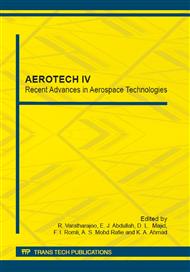p.219
p.225
p.233
p.239
p.245
p.250
p.255
p.261
p.267
An Investigation on the Effect of Variable Valve Timing on Piston Engine for Lightweight Aircraft
Abstract:
As the Lycoming engine had failed its attempt on using variable valve timing for aircraft piston engine back in 1940s, the idea of the technology was abandoned as the turbines were then introduced in the aviation for better performance and greater power. Since piston engines produce smaller power efficiently in the low speed than turbine engines, they are presently still practically used in most of lightweight aircraft. With the use of a variable valve timing mechanism, it may help to increase the amount of air inlet and to provide more power output with lesser fuel consumption. With the use of this new valve system, improvements in the performance of automobile engines have been recorded. The indicated improvements, however, are limited to automobile engines running with high revolutions only. Engine simulation program was run in this investigation as an attempt to predict engine performances that are appropriate for lightweight aircraft.
Info:
Periodical:
Pages:
245-249
Citation:
Online since:
November 2012
Price:
Сopyright:
© 2012 Trans Tech Publications Ltd. All Rights Reserved
Share:
Citation:


